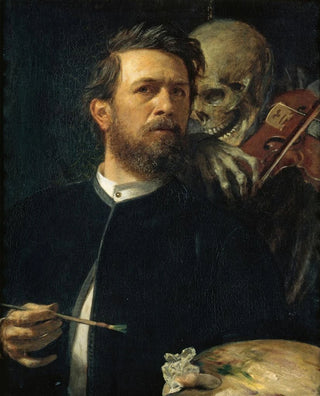Art print Self-portrait with Death playing the violin - Arnold Böcklin | Art print


View from behind

Frame (optional)
The artwork "Self-portrait with Death playing the violin" by Arnold Böcklin is a masterpiece that transcends the simple frame of the portrait to immerse the viewer in a universe that is both unsettling and fascinating. Created in the 19th century, this piece still resonates today through its exploration of themes of mortality, art, and the duality of human existence. Through this painting, Böcklin invites us to contemplate our relationship with death, while highlighting the ephemeral beauty of life. The artist, through his bold approach, manages to capture a suspended moment, a silent dialogue between the painter and his ultimate destiny.
Style and uniqueness of the work
The originality of this piece lies in how Böcklin blends realism with symbolic elements. The portrait, while being a faithful representation of the artist, is enriched by the presence of Death, personified in an almost familiar manner. This figure, dressed in a dark robe, plays the violin, an instrument that evokes both melancholy and harmony. The contrast between life and death is accentuated by the chosen colors, oscillating between dark shades and luminous flashes that emphasize the dramatic tension of the scene. The painter’s gaze, both thoughtful and serene, seems to defy fate, creating an introspective atmosphere. This duality offers multiple interpretations of the work, where each viewer can project their own emotions and reflections.
The artist and his influence
Arnold Böcklin, Swiss painter of the symbolist movement, established himself as a major figure of his time. His work is marked by a dreamlike approach and a fascination with mythological and mystical themes. Influenced by Romantic currents and a quest for escape into fantastic worlds, Böcklin managed to incorporate elements of nature and the supernatural into his creations. "Self-portrait with Death playing the violin" perfectly illustrates this trend, where the artist does not merely depict reality but seeks to reveal its depths.

Matte finish

View from behind

Frame (optional)
The artwork "Self-portrait with Death playing the violin" by Arnold Böcklin is a masterpiece that transcends the simple frame of the portrait to immerse the viewer in a universe that is both unsettling and fascinating. Created in the 19th century, this piece still resonates today through its exploration of themes of mortality, art, and the duality of human existence. Through this painting, Böcklin invites us to contemplate our relationship with death, while highlighting the ephemeral beauty of life. The artist, through his bold approach, manages to capture a suspended moment, a silent dialogue between the painter and his ultimate destiny.
Style and uniqueness of the work
The originality of this piece lies in how Böcklin blends realism with symbolic elements. The portrait, while being a faithful representation of the artist, is enriched by the presence of Death, personified in an almost familiar manner. This figure, dressed in a dark robe, plays the violin, an instrument that evokes both melancholy and harmony. The contrast between life and death is accentuated by the chosen colors, oscillating between dark shades and luminous flashes that emphasize the dramatic tension of the scene. The painter’s gaze, both thoughtful and serene, seems to defy fate, creating an introspective atmosphere. This duality offers multiple interpretations of the work, where each viewer can project their own emotions and reflections.
The artist and his influence
Arnold Böcklin, Swiss painter of the symbolist movement, established himself as a major figure of his time. His work is marked by a dreamlike approach and a fascination with mythological and mystical themes. Influenced by Romantic currents and a quest for escape into fantastic worlds, Böcklin managed to incorporate elements of nature and the supernatural into his creations. "Self-portrait with Death playing the violin" perfectly illustrates this trend, where the artist does not merely depict reality but seeks to reveal its depths.
12,34 €






